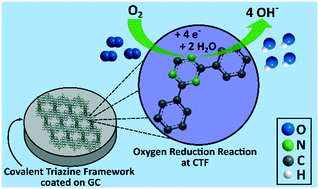Metal free-covalent triazine frameworks as oxygen reduction reaction catalysts – structure–electrochemical activity relationship†
Abstract
Nitrogen-rich porous carbon polymers are highly promising oxygen reduction reaction (ORR) catalysts and possess great potential to replace Pt-based precious metals used in energy storage and conversion systems. In this study, covalent triazine frameworks (CTFs) were synthesized via an ionothermal route based on different monomers and synthesis temperatures (400–750 °C) and tested in alkaline media with a rotating disk electrode (RDE). The effect of the applied monomer and temperature on the surface functionalities of the frameworks and thus correlation to their ORR activities are deeply discussed. Micro/mesoporous, hierarchically ordered and highly conductive N-rich materials with up to 2407 m2 g−1 specific surface areas and 2.49 cm3 g−1 pore volumes were achievable. Owing to the high surface area (1742 m2 g−1), pore volume (1.56 cm3 g−1), highest conductivity, electrochemically active surface area and hierarchical mesoporous structure, CTF DCBP-750 facilitated 0.9 V onset potential (only 0.06 V larger than that of the benchmark 10 wt% Pt/C) with 5.1 mA cm−2 limiting current density. In addition to the structural properties, graphitic nitrogen species, active sites responsible for binding and activating O2, rather than pyridinic nitrogen appear to be more important for the overall ORR performance. Thus, the trade-off point is crucial to obtain optimal ORR activity with metal-free CTFs.

- This article is part of the themed collection: Catalysis Science & Technology 10th Anniversary Symposium


 Please wait while we load your content...
Please wait while we load your content...